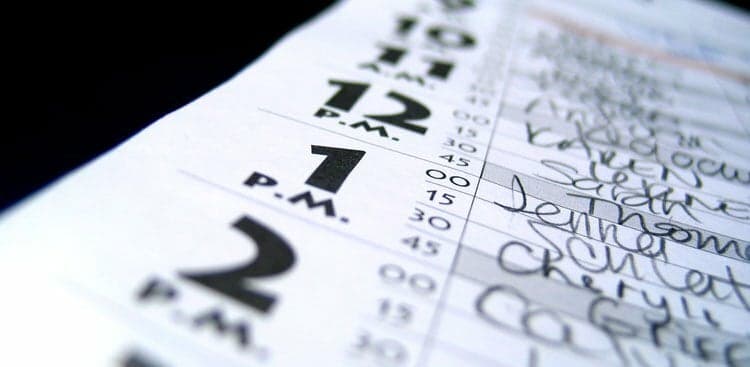My least favorite days at work are what I call “purple stacks.” My company uses Google Calendar, and the color for my personal schedule is purple, so on those dreadful days I see nothing but chunks of time blocked out from 9:30 AM to 6:30 PM. It always makes me wonder, “How the hell did this happen?”
In addition to feeling like I have no room to breathe or do actual work on those days, I fear being “that guy” who has to tiptoe from a meeting early, then spend extra time later to find out what I missed, or who shows up late to my next meeting because the previous one ran too long. (Since I wrote about never being late or unprepared for meetings, my co-workers are keeping me in check!)
“Busyness” is such a trick. It makes us feel that the longer our to-do lists are, the more successful we are. It makes us feel that the more we have on our plates, the more successful we are. But since when does having an overstuffed dinner plate give you anything but cramps or a food coma? It doesn’t have to be this way, and I’m making an open resolution to fight it.
Meetings end up on our calendars in two ways: because we accept them and because we create them. It’s at these decision points that we can do things a little differently to take back our calendars and give ourselves (and our co-workers) time to be prepared and productive. Here are three ways to do it:
1. Speak Up
Before you send or accept a meeting invitation, make sure that you understand what it should accomplish and how you should prepare. If you don’t, speak with the organizer and listen for whether there is a specific agenda. If there isn’t one, ask him or her to create one (or better yet, volunteer to help). The best agendas are specific with time allotments to ensure that all relevant items are being covered. If there isn’t enough time to create an agenda, volunteer to help the organizer keep an eye on the clock.
If you’re organizing the meeting, use an agenda to plan how long the meeting should be. Google’s calendar invitations default to one hour, and it’s easy to click “send” without thinking of shortening them, but that setting can be changed! You’ll be surprised how much you can cover in 15, 30, or 22 minutes. Depending on your relationship with the organizer, if you see that a meeting is scheduled to be an hour and you don’t believe it should be (because you understand the purpose and expected outcomes), ask for the time to be shortened.
Finally, if you’ve accepted an invitation for a meeting that ends at the same time another meeting is scheduled to start (seriously, how do we convince ourselves that we can be in two places at once?), give the organizer advance notice that you will need to leave that meeting early. Ideally, this will encourage the organizer to finish the meeting by the time you need to depart. At the very least, you’ll feel comfortable exiting without interrupting, and the organizer won’t be surprised when you do. For extra insurance, go ahead and let the organizer of your next meeting know that you may arrive late.
2. Pad Your Time
As soon as a meeting time is confirmed, and if your calendar has space around it, protect it! Add 15-30 minutes before and after the meeting called “Transition Time.” Before the meeting, use the time to review any materials, take a bathroom break, and arrive at the location before it starts. After the meeting, it’s a good period for you to reflect on the material while it’s still fresh. It’s reasonable to expect co-workers to be respectful of whatever is on your calendar; they’re just scheduling wherever there is common free time. So if a meeting wraps at 3 PM and you block time to recap afterward, they probably (hopefully?) won’t bristle at starting a new meeting at 3:15 or 3:30.
3. Block Your Time
This is the holy grail of productivity: having chunks of time—even days!—with no meetings. BuzzFeed has declared Tuesdays and Thursdays meeting-free. Can you? While it may take a deliberate effort among your company’s senior management to clear an entire day, it’s worth taking a look at your own work habits to see when you get your best work done. Are you a morning person, or do you really get cranking after 2 PM? Examine your schedule and see where you can block two to four hours just once a week to focus on doing or making. You just might set a trend in your company from the ground up!
So, this is my commitment to take back the calendar! Who’s with me?

